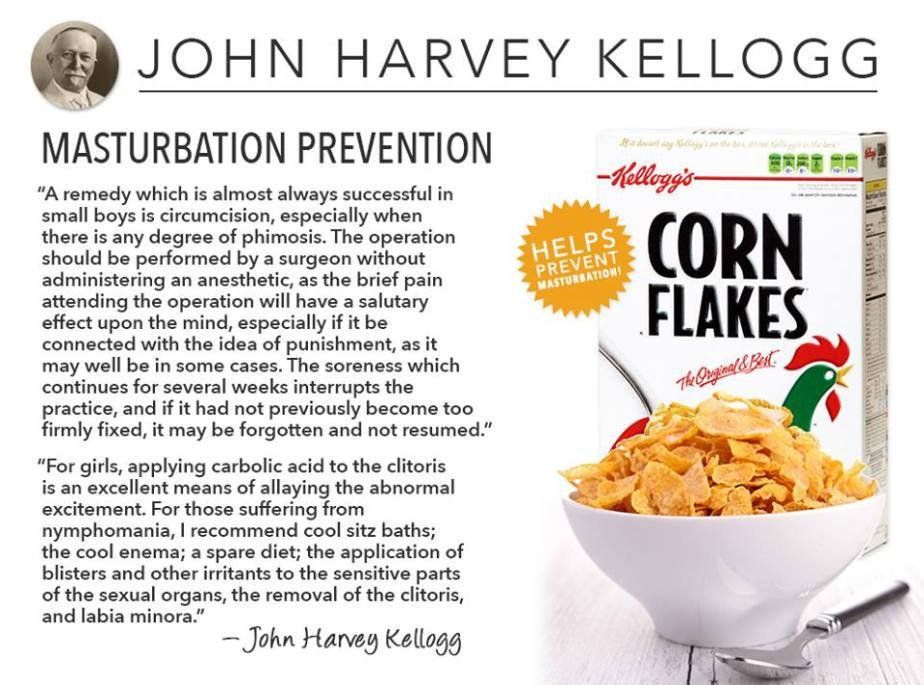The subject of intimacy is a popular, even glorified discussion among the 21st century; we are submersed in a sea of information whether it is books, blogs or movies. However in the 19th century pro-creation, the most natural part of life was shamed.
The 7-day Adventist movement believed that self-gratification was the devil’s work and anti-masturbation crusaders blamed self-gratification for a number of health crises that were prevalent at the time. Blindness, Insanity, Epilepsy, and Infertility were all thanks to masturbation! It seems crazy, does it not? Until you consider that smoking was promoted as a health-bestowing activity for many decades!
John Harvey Kellogg was an American nutritionist, health activist, and doctor of medicine. He had strong views about the relationship between masturbation and diet. For instance he believed the urge to masturbate (or as he liked to call it ‘self-pollute’) stemmed from eating meat (especially red meat) and seasoned foods.

The idea that masturbation is bad for you consumed 18th century thinking but was only accepted as medical practice during in the Victorian era! Like those of his time, John Harvey Kellogg was obsessed with the idea. He believed his patients were suffering from numerous mental and physical issues because they were masturbating too much. He was convinced was that a diet both bland and high in fiber would act as an edible “sex-stopping” way to eliminate any feelings of arousal emanating from the stomach.
Kellogg held the extreme views that were the norm of the day. He advocated cruel and horrendous treatments for to his patients that would never be accepted today: To prevent erections and irritation, he advised men to thread a silver wire through the foreskin, whereas for women, he suggested rubbing carbolic acid on the clitoris to burn and over-sensitise it and thus discourage touching.
Kellogg recommended that a truly healthy diet should consist of bland foods such as cereal grains and nuts. He believed this so passionately that he even went as far as creating foods to fit his philosophy.
As a superintendent of the ‘Battle of Creek Sanatorium’ (what today we might call a wellness retreat) he would serve guests biscuits made from oats, corn, and wheat crushed together. He named this dry, tasteless concoction “Granola”.
However he was technically not the first to do this: a diet guru with similar views beat him to it by creating a food with the same ingredients. The difference? He called it “Granula” (!) It is believed that Kellogg just changed the ‘U’ to an ‘O’ to evade lawsuits.
Later on John Kellogg and his booking-keeping brother Will Keith Kellogg (who also worked at the ‘Battle of Creek Sanatorium’), created cornflakes… BUT did they intend the cereal to be a sex stopping anaphrodisiac?
Will Kellogg wanted to market the food outside the constraints of ‘Creek Sanatorium’ and straight to corporate America. He suggested adding sugar to the cornflakes but John rejected the idea, as he believed people would go on a masturbating frenzy, thus eliminating the intended purpose of his creation. Will had zero interest in the dietary aspects of the cereal. What he saw was a business opportunity and he seized it, which caused discord and started a feud between the brothers.
Eventually they split and Kellogg’s was commercialised with the additional of sugar, and thereby transformed into a delicious best seller throughout America. Kellogg’s Cereals were a huge financial success, but the brothers’ feud lasted years.
We’ve given you the facts… YOU decide!
Many breakfast cereals are high in carbohydrates, which can cause a spike in blood sugar levels. In addition, many cereals are high in sugar, which can also contribute to high blood sugar levels. It’s also important to pay attention to portion sizes when eating cereal. Many people pour large bowls of cereal and may eat more than the recommended serving size. This can contribute to higher blood sugar levels and make it harder to control diabetes. Check the nutrition label on your cereal box and measure out the recommended serving size to avoid overeating.
. While some cereals can contribute to high blood sugar levels, others may be a healthy option for people with diabetes. If you have diabetes, it’s important to choose cereals that are high in fiber, low in sugar, and have a low glycemic index. Additionally, pay attention to portion sizes to avoid overeating. With careful selection and moderation, cereal can be a part of a healthy breakfast for people with diabetes.

BOOK A FREE CONSULTATION
You can get help immediately by signing up for a free (no obligation) 15-minute consultation with the founder of ProLongevity. We can support you in maintaining your new year regime!
Graham Phillips, our founder of ProLongevity, is a registered pharmacist, Fellow of the Royal Pharmaceutical Society and the owner of iHeart Pharmacy Group, a multi-award-winning community pharmacy group based in Hertfordshire and Kent.
ProLongevity was founded in 2017 with a lofty aim: to help people all over the world to live longer, healthier, happier lives. Since then, we’ve helped hundreds of people to transform their health through simple yet powerful lifestyle changes.
ProLongevity Gold can help you too, for as little as £3.90 per day





